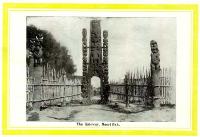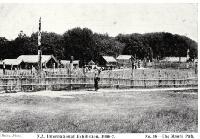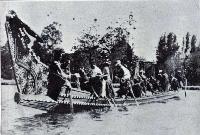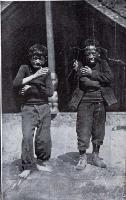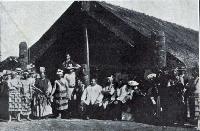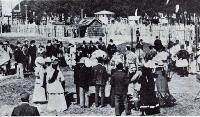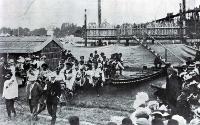Te Araiteuru Pa: The Māori Pa
- A series of traditional Māori buildings of different kinds were built to mimic a pa or village of older times.
- The model Māori Pa set out to portray "traditional" Māori life and customs.
- At the time people strongly believed that the Māori race would eventually die out and this part of the exhibition allowed visitors to "experience" Māori culture while they still could.
"The Māori Pa" was a stockaded area occupying about 2 acres (almost a hectare) at the rear of the show-grounds, stretching back from the western end of Lake Victoria. It was the Government’s own exhibit, with special funding, and for which the Minister of Native Affairs, James Carroll was responsible. He placed Augustus Hamilton, the Director of the Colonial Museum in charge of the project, with Gregor McGregor, a Pakeha farmer from the Whanganui River area as site superintendent. There were only two Māori members on the organising committee, J.H.W. Uru of Ngāi Tahu and Peter Henry Buck. Management of the project was undertaken largely by European ethnologists, such as Hamilton, T.E. Donne, John Macmillan Brown, James McDonald and James Cowan.
Buildings and Layout
The Pa was fronted by a magnificent 22 foot (6.7 metres) high entrance-way, constructed by Hori Pukehika of Whanganui.
The area inside was divided into two sections, defended by successive lines of entrenchment and surrounded by several pūhara (watch-towers) between 20 and 30 feet (6 and 9 metres) high. It was modelled on a waterside pa, rather than a hillside pa, and was thus a combination of fishing village, waterside stockade and trenched residential town. The trenches were about 4 feet (1.2 metres) deep and 3 feet (1.9 metres)wide, and the fence consisted of sharp stakes, with stout posts every few yards, 7 feet (2.1 metres) high.
The Outer Pa
The Outer Pa contained a large ceremonial meeting house, called "Ohinemutu" by the Te Arawa group who first stayed there. The meeting house and the large open space in front of it formed a marae. This house, measuring 40 feet (12 metres) by 20 feet (6 metres), was a composite structure, made up of various pieces from museums and some elements specially carved for the occasion. The figure at the foot of the poutokomanawa (central house pillar) and some other carvings were obtained from a house originally built in Taranaki. An ornate pataka (storehouse) carved especially for the exhibition also stood in the Outer Pa. This building was later re-erected at Whakarewarewa Model Village in Rotorua. Many other carvings were also commissioned for the exhibition and were completed under Hamilton’s close supervision, either in Wellington or on site in Christchurch.
The Inner Pa
The Inner Pa was defended by a double pallisade of tawai sapling fences. The gateway to the Inner Pa was especially carved by Neke Kapua of Rotorua, his sons, Eramiha Neke Kapua and Tene Neke, and other family members. Inside the Pa were -
- 20 whare puni (dwelling houses)
- a tohunga’s house
- 2 cook-houses
- the model meeting house "Te Wharepuni-a-Maui"
The whare puni were said to be examples of different styles of Māori dwellings, and provided accommodation for visiting groups. The tohunga’s house was also used for accommodation by Peter Buck. The cook-houses were brought almost complete from kainga (villages) on the banks of the Whanganui River whereas "Te Wharepuni-a-Maui" was a building that had been commissioned by T.E. Donne in 1905. Donne leased this building to the organisers for the duration of the Exhibition at a charge of £25. The meeting house measured only 20 feet by 12 feet (6 metres by 3.7 metres), and was "really only a large model and never intended for actual use". 1 It is currently located at the Linden Museum in Stuttgart.
Meeting house carvings
These carvings came from a house built in Puniho, Taranaki about 1875 and were done by a man called Parehe. This house formed the centrepiece of a Māori replica village at an industrial exhibition in New Plymouth in 1904-5. It was later sold by antique dealer James Butterworth to Augustus Hamilton at the Dominion Museum, and he sent them to Christchurch to form part of the Exhibition Pa’s meeting house. After the Exhibition closed, the carvings were stored at the Canterbury Museum. There they remained until 1989, when Ashley Spice, who grew up in Puniho, was instrumental in arranging for the carvings to be returned to Taranaki. The carvings are now on display at Puke Ariki.
Waka
There were a number of waka (canoes) at the Pa, most of which had been purchased by Gregor McGregor during a trip up the Whanganui River. The names of four are known: the Te Uru, the Muritai, the Whatawhata, and the Waiapu.
A large ceremonial waka, the Taheretikitiki, 84 feet (25 metres) long with a 5-foot (1.5 metre) beam amidships, was loaned by Mahuta Tāwhiao Pōtatau Te Wherowhero, probably at the request of Carroll. The canoe had been built about 1880 on the Kaipara River for Paora Tuhaere of Orakei, who presented it to King Tāwhiao.
Visitors
The Pa was peopled by various groups of Māori during the Exhibition, about 500 individuals staying there at different times.
- The first residents were 57 men, women and children from Whanganui and Rotorua, including skilled carvers and weavers, and haka and poi dancers.
- From late November until mid-December, there were 78 Te Arawa entertainers in residence (56 men and 22 women) who were selected and managed by Gilbert Mair.
- Turakina Girls' School made two visits, the second in late March.
- Whanganui people recruited by McGregor and led by Wikitoria Kepa arrived in late January.
- In February and March there were two large parties of Ngāti Kahungunu, numbering nearly 200 people.
Other visitors that came to the Pa, included groups of Fijians and Cook Islanders, as well as notable chiefs such as Mahutu Te Toko (a cousin of King Tāwhiao), Hori Pukehika, Matutaera Nihoniho, and Tuwharetoa chief Tureiti Te Heuheu Tukino V. Well-known Rotorua guides Makereti Papakura and her sister, Bella Reretupou also spent some time at the Pa.
Notable by their absence were members of the local iwi, Ngāi Tahu, who played a very minor part in the Exhibition. Dissatisfaction with the Government over unresolved land claims and other grievances was probably behind their refusal to become involved. These issues had become even more sensitive with the passing of the South Island Landless Natives Act in 1906.
Entertainment
The Pa was open to the public from 10.30am-7.30pm each day, with an entry fee of 6d. An exhibition of haka and poi performances was given daily at 3pm. It proved very popular, with 60,000 people visiting during the period of the Exhibition.
The Pa was designed to provide a working example of ancient Māori life and customs, or, as Cowan described it, "semi-barbaric life and colour". Residents were expected to be dressed in traditional Māori costume at all times. Food was to be stored in the pataka and cooked over open fires, in stone-lined ovens in the ground, or in hot pools. Entertainment included, on one night, a mock battle between the Ngāti Kahungunu people and Pakeha volunteers, and on another occasion a mock attack against warriors in the stockade was made by waka crews approaching across the lake. Māori also provided entertainment in the nearby "Geyserland".
Māori culture as novelty
The Pa was not really an authentic representation of an historic site as much as it was a portrayal of a somewhat "artificial" Māori culture of the past. This "romanticised version of ancient Māori life" 2 was appealing to Pakeha visitors as well as presenting a unique entertainment and educational opportunity. Māori were seen as "noble savages" - wise chiefs, heroic warriors and romantic lovers which featured in European visions of "Māoriland". These stereotypical Māori characters were also seen in the sculptures of Māori figures in the Exhibition’s main hall. In fact, these ideas of Māori life had little connection with reality and assumed Māori were a "dying race". The Pa, and its inhabitants, represented a idyllic past, picturesque and theatrical but relevant only as entertainment. The Pa was seen as a way of preserving Māori culture as a "curiosity" for the enjoyment and education of the visiting public. The emphasis on performance and "theatre" was perhaps demonstrated most clearly when Te Rangi Hiroa (Peter Buck) led an "English haka" 3 performed by English businessmen dressed in Māori costume, as "Pakeha Māori for a day".4
A dying race?
At the time the Māori population was beginning to recover from the combined effects of introduced diseases and the arrival of large numbers of foreigners that had seen the population figures plummet to just 42,113 in 1896. However many Europeans still saw them as "a dying race" or at least as a race which would soon become fully assimilated within the"superior" European people. The Press stated that once the old Māori died, so too would their traditions because the younger Māori had no knowledge of them, nor, it was implied, any need of them. This belief was in part the reason for the existence of the Pa at the Exhibition.
![]()
Related photos
Sources
- Duval, T. "Arai-te-uru Pa", Te Karanga, Feb. 1987, page 4-17
- Kernot, B. "Māoriland Metaphors and The Model Pa". In J.M. Thomson (Ed.), Farewell colonialism : the New Zealand International Exhibition, Christchurch, 1906-07, page 61-78
- McNaughton, H. "Mixing metonyms: staging Polynesia in the 1906 Christchurch International Exhibition", in H. McNaughton & J. Newton (eds), Figuring the Pacific: Aotearoa & Pacific cultural studies, page 83-97
- Neich, R. Carved histories : Rotorua Ngāti Tarawhai woodcarving
- Spice, A. "’A tangi out the coast’: Puniho Pa, Taranaki", in K. Gentry and G. McLean (eds) Heartlands, page 243-246
- "The International Exhibition - Māori Representation" The Press, 6 March 1906, page 8
Related links
Biographies
- James Carroll in the Dictionary of New Zealand Biography
- Augustus Hamilton in the Dictionary of New Zealand Biography
- Peter Henry Buck in the Dictionary of New Zealand Biography
- John Macmillan Brown in the Dictionary of New Zealand Biography
- James McDonald in the Dictionary of New Zealand Biography
- James Cowan in the Dictionary of New Zealand Biography
- Hori Pukehika in the Dictionary of New Zealand Biography
- Eremiha Neke Kapua in the Dictionary of New Zealand Biography
- Mahuta Tāwhiao Pōtatau Te Wherowhero in the Dictionary of New Zealand Biography
- Paora Tuhaere in the Dictionary of New Zealand Biography
- Tukaroto Matutaera Pōtatau Te Wherowhero Tāwhiao (King Tāwhiao) in the Dictionary of New Zealand Biography
- Gilbert Mair in the Dictionary of New Zealand Biography
- Matutaera Nihoniho in the Dictionary of New Zealand Biography
- Tureiti Te Heuheu Tukino V in the Dictionary of New Zealand Biography
- Makereti Papakura in the Dictionary of New Zealand Biography
- Makereti Papakura in her book The Old-time Māori
Other links
- "Te Hui Whakakitekite Otautahi" (The Great Exhibition at Christchurch), Te Pipiwharauroa, November 1906, page 4
- Māori Material Culture - The Pa in An Encyclopaedia of New Zealand 1966
The passing of the Māori - what we’re coming to from Te Ara: The Encyclopedia of New Zealand
Footnotes
- [1]Neich, R. Carved histories : Rotorua Ngāti Tarawhai woodcarving. page 213
- [2] Kernot, B. "Māoriland Metaphors and The Model Pa". In J.M. Thomson (Ed.), Farewell colonialism : the New Zealand International Exhibition, Christchurch, 1906-07, page 61
- [3] [4] McNaughton, H. "Mixing metonyms: staging Polynesia in the 1906 Christchurch International Exhibition", in H. McNaughton & J. Newton (Eds), Figuring the Pacific: Aotearoa & Pacific cultural studies, page 90




